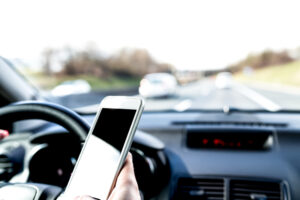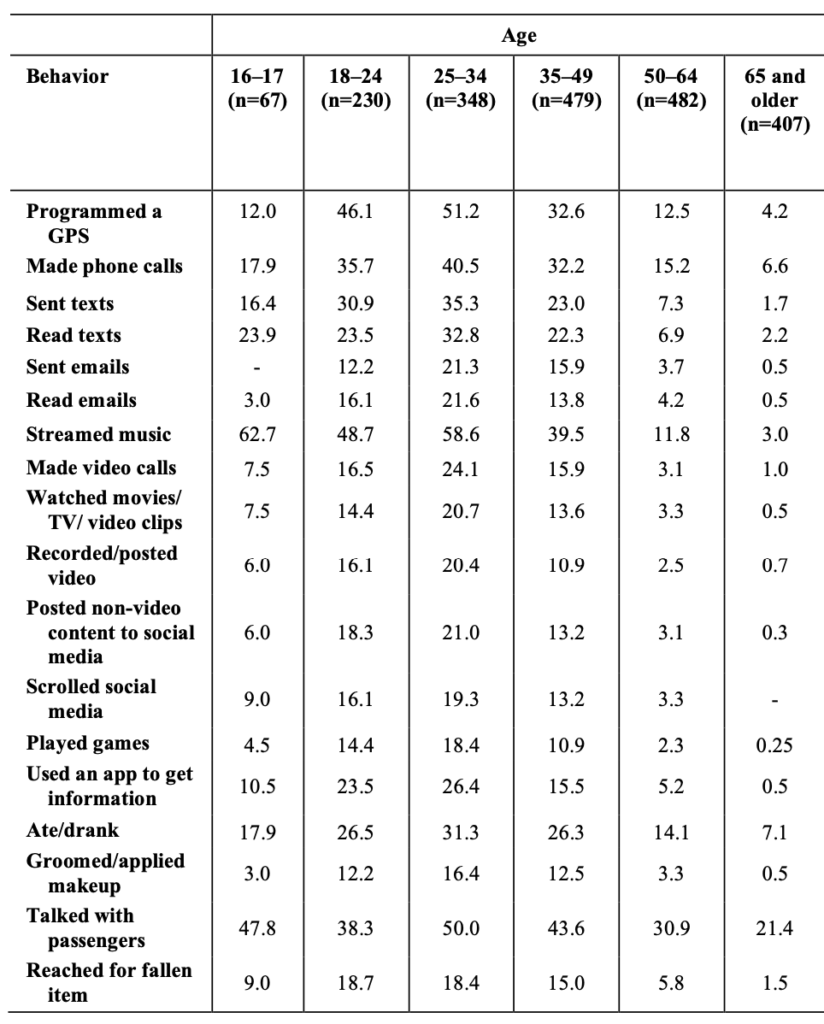
Use of smartphone apps while driving prevalent, especially among gig workers, IIHS finds
By onAnnouncements | Insurance | Technology
The use of smartphone apps most or all of the time while driving is widespread, and more prevalent among drivers younger than 50, a new survey by the Insurance Institute for Highway Safety (IIHS) has found.
In addition, the survey found that gig-economy workers are four times as likely as other drivers to use smartphone apps regularly while driving. Their activities “went well beyond communicating with customers and navigating to pickup and delivery locations using the app provided by their employer,” the survey said.
The survey, “Prevalence of distracted driving by driver characteristics in the United States,” is based on a nationwide survey of 2,013 U.S. licensed drivers ages 16 and older.
“The explosion of smartphone features and services has not only created new forms of driver distraction, but also a new group of rideshare and delivery drivers whose jobs require them to interact with their phones while they’re on the road,” IIHS President David Harkey said in a media release.
The survey’s authors suggest that ride-sharing companies develop or strengthen policies prohibiting device-based behaviors that are not essential to the service, while “mandating safe practices for the tasks that are deemed essential.”
“Ride-share applications should, if they do not already, automatically set routes to reduce driver interactions with navigation applications,” the survey says. “These actions would provide safeguards for drivers, their customers, and other road users.”
The two dominant rideshare services, Uber and Lyft, had a combined 2.5 million drivers as of 2021, according to the website www.therideshareguy.com.
The survey also found that parents are nearly 50% more prone to routinely making video calls, checking weather reports and other types of smartphone-enabled distractions than drivers without children 18 or younger.
“These results show that nobody is immune to distraction and suggest that hands-free capabilities may be making us a little too comfortable using our phones and other devices behind the wheel,” Harkey said.
According to National Highway Traffic Safety Administration (NHTSA) statistics, more than 3,000 people died in distraction-related crashes in 2020, representing 8% of all traffic-related fatalities. Because it’s hard to determine if distraction contributed to a crash, that number is “almost certainly an underestimate,” IIHS said.
“Anything that diverts the driver’s attention — eating, adjusting the radio, putting on makeup — can increase the risk of a crash. But tasks involving mobile phones and other electronic devices can be both more demanding and more tempting than other common distractions. The variety of smartphone applications has also exploded in recent years,” IIHS said.
Most drivers reported that they usually used the hands-free feature for device-based activities when it was available. About 80% of drivers, for instance, who regularly used their navigation app said they used voice commands to do so, as did 70% of those who read and sent texts.
“Hands-free operation is generally believed to be less dangerous, since drivers can more easily keep their eyes on the road,” said IIHS Research Associate Aimee Cox, the lead author of the study. “However, it doesn’t eliminate the distraction altogether.”
For instance, IIHS said, previous research has found that some hands-free features require drivers to perform some operations manually, such as scrolling through a contact list, making them less safe than features that rely solely on voice commands.
In addition, “Hands-free capabilities are irrelevant or impractical for some smartphone-based activities, such as scrolling social media or playing games,” IIHS said. The survey noted that one in five regularly engaged in a modern device-based distraction, with 8% playing games, 10% watching and 9% recording videos, and 9% scrolling and 10% posting to social media regularly while driving.
Survey participants were asked to report whether they performed any of 18 individual secondary tasks while driving, 14 of which were related to the use of devices. These including such tasks as sending and receiving email, streaming music, and watching a movie.
Researchers then estimated the proportion of drivers study-wide and by demographic characteristics belonging to each category, defined as those who regularly did one or more secondary tasks within each category. Regular engagement was defined as during most or all drives in the previous 30 days.
The chosen demographic characteristics were age, gender, race/ethnicity, parental status, driving frequency, education, employment (including a separate question on gig economy employment), and income.
The activities were not broken down by app, but grouped apps together in categories, such as “Record and post or livestream a video on a social media app (TikTok, Facebook, Instagram, etc.)”
Aside from streaming music, which was most common for drivers ages 16 and 17, teen drivers were less likely to perform device-based tasks than young adult groups through the early 30s, the survey said.
“This generally supports findings from other nationwide distracted driving surveys demonstrating that young adults are engaging in common device-based activities more often than novice and middle-aged or older drivers,” the survey said.
Still, teens did most frequently report performing non-device tasks like talking with passengers, the survey said. “Passenger distractions are associated with increased crash risks for teens, which is why passengers are often restricted in graduated driver licensing programs.”
Last month, Honda announced that it is providing more than $2 million in financial support for 25 organizations across the United States that are taking a variety of approaches to increasing teen driver safety.
The grants support education, training and resources that supplement or build on traditional driver’s training courses or mandated state driver’s programs, Honda said.
“Honda is pleased to support organizations actively working in their local communities, and at the national level, to advance driver education and safety awareness,” said Yvette Hunsicker, vice president of Corporate Social Responsibility and Inclusion & Diversity at American Honda Motor Co., Inc. “Together, we hope to identify the most effective ways to reach and positively influence young drivers.”
The teen driver safety initiative builds on Honda’s longstanding “Safety for Everyone” approach, a commitment to advance safety for everyone sharing the road. Honda also has added information on teen safety to the safety education section of its consumer website.
Images
Featured image by lovro77/iStock
Chart shows the percentage of study sample who reported doing the following secondary tasks most or every time they drove in the past 30 days, by age. (Provided by IIHS)

